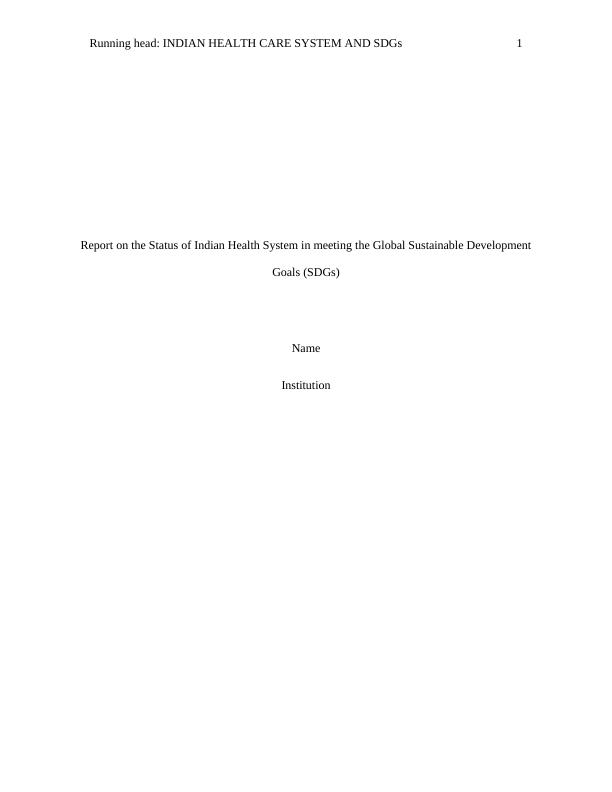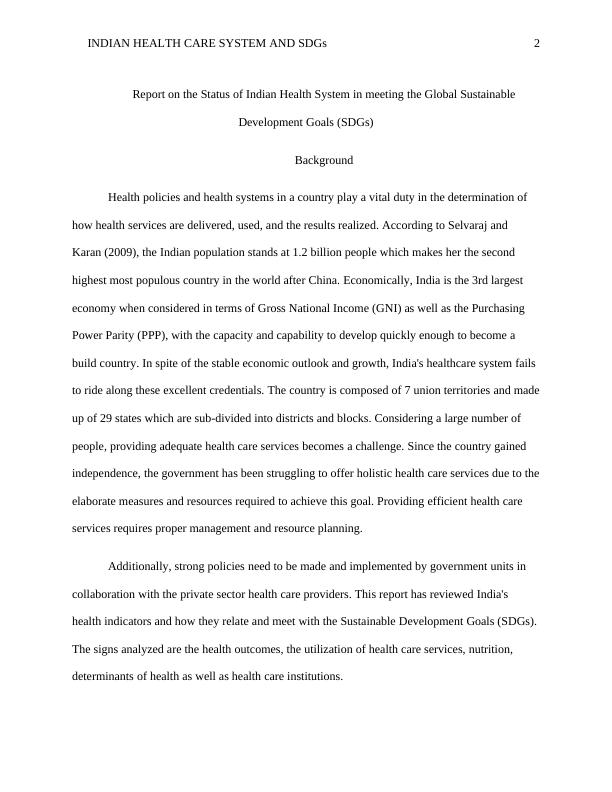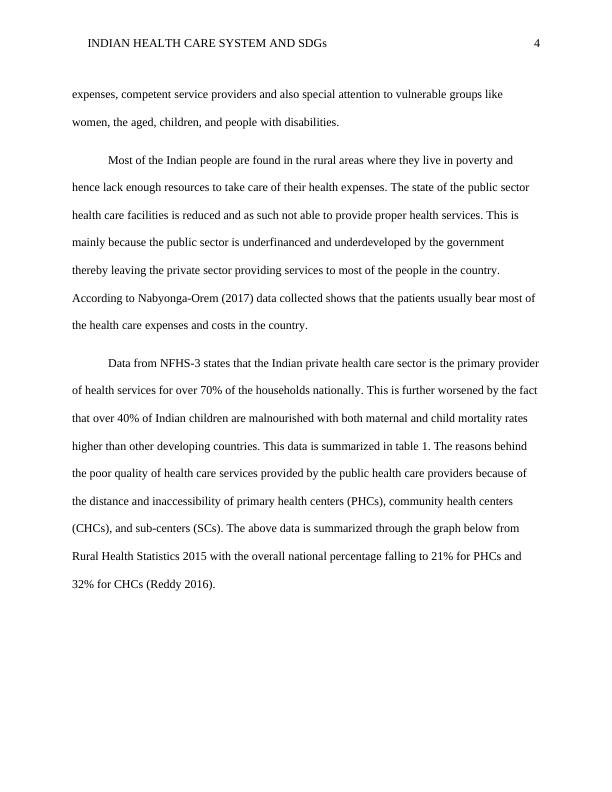Report on the Status of Indian Health System in meeting the Global Sustainable Development Goals (SDGs)
Added on 2023-04-08
13 Pages2611 Words149 Views
Running head: INDIAN HEALTH CARE SYSTEM AND SDGs 1
Report on the Status of Indian Health System in meeting the Global Sustainable Development
Goals (SDGs)
Name
Institution
Report on the Status of Indian Health System in meeting the Global Sustainable Development
Goals (SDGs)
Name
Institution

INDIAN HEALTH CARE SYSTEM AND SDGs 2
Report on the Status of Indian Health System in meeting the Global Sustainable
Development Goals (SDGs)
Background
Health policies and health systems in a country play a vital duty in the determination of
how health services are delivered, used, and the results realized. According to Selvaraj and
Karan (2009), the Indian population stands at 1.2 billion people which makes her the second
highest most populous country in the world after China. Economically, India is the 3rd largest
economy when considered in terms of Gross National Income (GNI) as well as the Purchasing
Power Parity (PPP), with the capacity and capability to develop quickly enough to become a
build country. In spite of the stable economic outlook and growth, India's healthcare system fails
to ride along these excellent credentials. The country is composed of 7 union territories and made
up of 29 states which are sub-divided into districts and blocks. Considering a large number of
people, providing adequate health care services becomes a challenge. Since the country gained
independence, the government has been struggling to offer holistic health care services due to the
elaborate measures and resources required to achieve this goal. Providing efficient health care
services requires proper management and resource planning.
Additionally, strong policies need to be made and implemented by government units in
collaboration with the private sector health care providers. This report has reviewed India's
health indicators and how they relate and meet with the Sustainable Development Goals (SDGs).
The signs analyzed are the health outcomes, the utilization of health care services, nutrition,
determinants of health as well as health care institutions.
Report on the Status of Indian Health System in meeting the Global Sustainable
Development Goals (SDGs)
Background
Health policies and health systems in a country play a vital duty in the determination of
how health services are delivered, used, and the results realized. According to Selvaraj and
Karan (2009), the Indian population stands at 1.2 billion people which makes her the second
highest most populous country in the world after China. Economically, India is the 3rd largest
economy when considered in terms of Gross National Income (GNI) as well as the Purchasing
Power Parity (PPP), with the capacity and capability to develop quickly enough to become a
build country. In spite of the stable economic outlook and growth, India's healthcare system fails
to ride along these excellent credentials. The country is composed of 7 union territories and made
up of 29 states which are sub-divided into districts and blocks. Considering a large number of
people, providing adequate health care services becomes a challenge. Since the country gained
independence, the government has been struggling to offer holistic health care services due to the
elaborate measures and resources required to achieve this goal. Providing efficient health care
services requires proper management and resource planning.
Additionally, strong policies need to be made and implemented by government units in
collaboration with the private sector health care providers. This report has reviewed India's
health indicators and how they relate and meet with the Sustainable Development Goals (SDGs).
The signs analyzed are the health outcomes, the utilization of health care services, nutrition,
determinants of health as well as health care institutions.

INDIAN HEALTH CARE SYSTEM AND SDGs 3
The endeavor by India to achieve the SDGs in a proper and timely fashion is vital not just
for the country's economic development but also for the entire world. This is significant because
of India's high population size as well as the enormous inequalities in the demographic and
socio-economic parameters all over the nation. Although it is one of the largest and fastest
growing economies in the world, the country's human development index is lower when
compared to those of other developing countries like China, Brazil, South Africa, and Russia.
India is the most significant contributor to the world under five deaths for the last four decades
recording over 1.2 million under-five deaths in 2015 which is over six times more than China. To
add to this, India is among the top five countries in the world with over 60% of its population
living in extreme poverty. As at the 2011 census, the ratio of poverty head in India was 22%
which has significantly been caused by the widespread hunger based on research done by
Ramani and Mavalankar (2006).
System of Governance, Policies and Impacts on the Health Care System
The federal nature of India's system of government has devolved the management,
governance, and operations of the country's health system between the union and the state
governments. In India, there is a mixed system of health care which includes the public and
private service sector providers. The health care system is categorized into primary, secondary
and tertiary levels. Most of the urban areas are served by the private health care providers who
cater to the secondary and tertiary needs. On the other hand, the rural areas are mainly served by
the public health care providers who are developed in the three-tier system by the norms of the
population. An ideal health care system is composed of four main components (Chatterjee,
Kakkar and Chaturvedi, 2016). They are universal access, equitable distribution of financial
The endeavor by India to achieve the SDGs in a proper and timely fashion is vital not just
for the country's economic development but also for the entire world. This is significant because
of India's high population size as well as the enormous inequalities in the demographic and
socio-economic parameters all over the nation. Although it is one of the largest and fastest
growing economies in the world, the country's human development index is lower when
compared to those of other developing countries like China, Brazil, South Africa, and Russia.
India is the most significant contributor to the world under five deaths for the last four decades
recording over 1.2 million under-five deaths in 2015 which is over six times more than China. To
add to this, India is among the top five countries in the world with over 60% of its population
living in extreme poverty. As at the 2011 census, the ratio of poverty head in India was 22%
which has significantly been caused by the widespread hunger based on research done by
Ramani and Mavalankar (2006).
System of Governance, Policies and Impacts on the Health Care System
The federal nature of India's system of government has devolved the management,
governance, and operations of the country's health system between the union and the state
governments. In India, there is a mixed system of health care which includes the public and
private service sector providers. The health care system is categorized into primary, secondary
and tertiary levels. Most of the urban areas are served by the private health care providers who
cater to the secondary and tertiary needs. On the other hand, the rural areas are mainly served by
the public health care providers who are developed in the three-tier system by the norms of the
population. An ideal health care system is composed of four main components (Chatterjee,
Kakkar and Chaturvedi, 2016). They are universal access, equitable distribution of financial

INDIAN HEALTH CARE SYSTEM AND SDGs 4
expenses, competent service providers and also special attention to vulnerable groups like
women, the aged, children, and people with disabilities.
Most of the Indian people are found in the rural areas where they live in poverty and
hence lack enough resources to take care of their health expenses. The state of the public sector
health care facilities is reduced and as such not able to provide proper health services. This is
mainly because the public sector is underfinanced and underdeveloped by the government
thereby leaving the private sector providing services to most of the people in the country.
According to Nabyonga-Orem (2017) data collected shows that the patients usually bear most of
the health care expenses and costs in the country.
Data from NFHS-3 states that the Indian private health care sector is the primary provider
of health services for over 70% of the households nationally. This is further worsened by the fact
that over 40% of Indian children are malnourished with both maternal and child mortality rates
higher than other developing countries. This data is summarized in table 1. The reasons behind
the poor quality of health care services provided by the public health care providers because of
the distance and inaccessibility of primary health centers (PHCs), community health centers
(CHCs), and sub-centers (SCs). The above data is summarized through the graph below from
Rural Health Statistics 2015 with the overall national percentage falling to 21% for PHCs and
32% for CHCs (Reddy 2016).
expenses, competent service providers and also special attention to vulnerable groups like
women, the aged, children, and people with disabilities.
Most of the Indian people are found in the rural areas where they live in poverty and
hence lack enough resources to take care of their health expenses. The state of the public sector
health care facilities is reduced and as such not able to provide proper health services. This is
mainly because the public sector is underfinanced and underdeveloped by the government
thereby leaving the private sector providing services to most of the people in the country.
According to Nabyonga-Orem (2017) data collected shows that the patients usually bear most of
the health care expenses and costs in the country.
Data from NFHS-3 states that the Indian private health care sector is the primary provider
of health services for over 70% of the households nationally. This is further worsened by the fact
that over 40% of Indian children are malnourished with both maternal and child mortality rates
higher than other developing countries. This data is summarized in table 1. The reasons behind
the poor quality of health care services provided by the public health care providers because of
the distance and inaccessibility of primary health centers (PHCs), community health centers
(CHCs), and sub-centers (SCs). The above data is summarized through the graph below from
Rural Health Statistics 2015 with the overall national percentage falling to 21% for PHCs and
32% for CHCs (Reddy 2016).

End of preview
Want to access all the pages? Upload your documents or become a member.
Related Documents
Report on Issue of Maternal Health in Indialg...
|15
|3357
|141
Imagining Health in Social and Cultural Contextslg...
|9
|2613
|104
HAS 911: Contemporary Public Health Issueslg...
|14
|3623
|195
The Impact of India's Health Sector on the Development of the Worldlg...
|8
|2733
|266
Comparing Healthcare Systems: China vs New Zealandlg...
|17
|5038
|182
Comparison of World issues between India and Singaporelg...
|10
|941
|268
